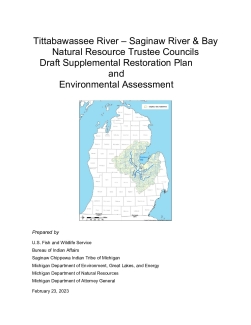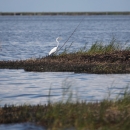
This Draft Supplemental Restoration Plan considers restoration proposals that have been identified by stakeholders with interests in the Saginaw Bay watershed. These proposals have been evaluated by the Trustees relative to the restoration criteria provided within their previously published restoration plans. The Trustees’ evaluation of the restoration proposals also meets the requirements for an environmental assessment, commonly referred to as an ‘EA’, consistent with the National Environmental Policy Act. Consequently, this document is both a restoration plan and an environmental assessment, and hereafter will be referred to as the ‘Draft Supplemental Plan’ or the ‘Draft Supplemental Restoration Plan.’ This Draft Supplemental Restoration Plan is ‘tiered’ from the two previously published plans, meaning that those two restoration plans remain relevant and applicable to this document, forming the foundation for the analyses reported here.
This Draft Supplemental Restoration Plan and Environmental Assessment relies upon criteria established in the completed restoration plans previously published by the two Trustee Councils working within the Saginaw Bay watershed. These Restoration Plans are the 2020 Final Restoration Plan / Environmental Assessment For the Tittabawassee River System Natural Resource Damage Assessment and the 2021 Final Restoration Plan & Environmental Assessment for Use of Remaining Funds - 1998 Saginaw River and Bay Settlement. These restoration plans evaluated restoration alternatives and their potential environmental impacts and the impact of adopting a ‘No Action’ alternative. In both cases, the alternatives selected by the respective Trustee Councils made provision for the future adoption and funding of stakeholder identified restoration projects.
On November 4, 2021, the two Trustee Councils jointly announced the availability of funding for restoration projects to be implemented in the Saginaw Bay watershed, including in and along the Tittabawassee and Saginaw Rivers. Two sources provided funding for this effort, the 2020 settlement with The Dow Chemical Company, and a 1998 settlement with General Motors Corporation. The two Trustee Councils have allocated a total of up to $5.75 million to fund stakeholder identified restoration projects, in addition to funding projects already identified in the respective restoration plans for the two settlements.
This Draft Supplemental Restoration Plan considers the pre-proposals received from stakeholders with interests in the Saginaw Bay watershed. The Draft Supplemental Restoration Plan presented here provides an introduction and background to the two settlements; the current status of implementation of the existing restoration plans for the two settlements; a brief summary of the affected environment for the proposed restoration projects in the Saginaw Bay watershed; descriptions of the stakeholder restoration pre-proposals considered by the Trustees as restoration alternatives; an analysis of the environmental consequences of the alternatives considered; and, a summary of the analysis that includes the description of the alternative proposed as the Trustees’ preferred alternative.
This Draft Supplemental Restoration Plan has been released for public review and comment. The Trustees will consider comments received from the public when making a final selection of an alternative composed of multiple restoration projects.

